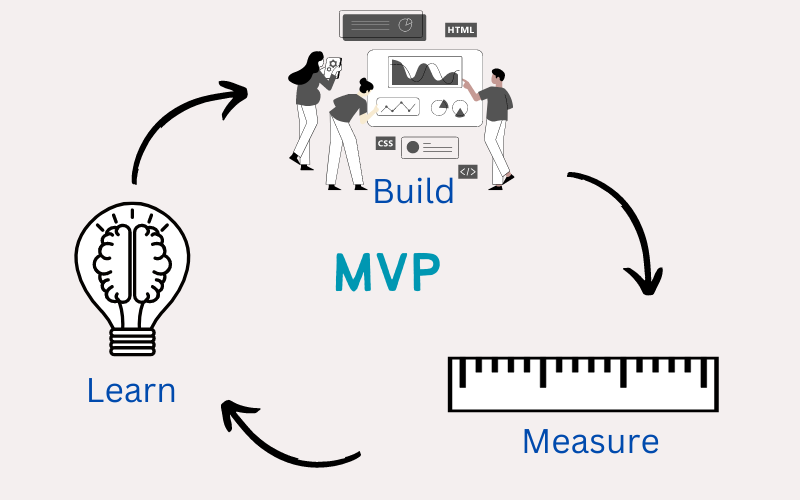How to Develop a Minimum Viable Product (MVP): A Step-by-Step Guide
What do apps like Dropbox, Uber, Figma, Spotify, and Instagram, all of which have achieved massive success, have in common? All of these businesses have employed an MVP methodology to not only ensure the sustainability of their products but also to develop core features. With iterative development and input from users, these apps improved over time using the minimum viable product (MVP) methodology. After some time, these developed into the fully functional apps we use today.
The goal of developing a Minimum Viable Product (MVP) is to ship a working version of the product with only the functionality necessary to address a critical issue. The goal of releasing a minimum viable product (MVP) is to reduce the initial investment, collect helpful user input, and inform future development.
The term "minimum viable product" (MVP) is used to describe a product or service that has only the most fundamental components necessary to attract and retain an initial user base. Collecting useful input for future product iterations is an important part of the follow-up process.

Significance of an MVP
The goal of creating a minimum viable product is to get a product to market rapidly on the back of a proven concept and a limited budget. Businesses can take advantage of MVP development solutions to get primary product user input for future updates. Finding the correct audience, drawing on relevant experience, and cutting development time down to size are all possible with an MVP.
An MVP can be used to demonstrate the value of the business and gain support from key stakeholders. If you want to convince internal or external investors to back your project, or if you just want to get started on developing your product, an MVP will help you do both.
What are some of the best ways to make an MVP?
Some of the best ways to become an MVP are:
How to Create a Minimum Viable Product
This step is a part of the MVP framework for agile app development, which Vconnex Services uses for our mobile app development projects.By following these steps, you'll be able to figure out which features are most important and how to rank them. You'll also be able to confidently list what you need to get your MVP on the market.
Step 1: Do Research on the Market
The first step is to figure out if the market needs your product. Ideas don't always fit what the market wants. Before a business starts working on an idea and starts the MVP Development process, it should make sure that the idea meets the needs of the people who will be using it. Surveys are a good idea for any business. The more a business knows, the more likely it is to be successful. Also, don't forget to keep an eye on what your competitors are selling and how your idea can be different. Also, you should consider what your competitors are doing and determine how to differentiate your offering. This can help decide the type of software you require for success.
Step 2: Think Of Ways To Add Value
Once you've figured out the user flow, you'll want to make a pain-and-gain map for each action. The pain and gain map lets you figure out all the things that bother users and what they get out of them. Using this method, you can figure out where you can add the most value. Then, you can focus your MVP on these areas and add the ones that aren't as important to your product roadmap for future releases.
Step 3: Plan the flow of users.
A key part of the MVP stage is the design process. So, you should make the app so that it is easy for people to use. The company needs to look at the app from the user's point of view, from the moment the app is opened to the end process, like making a purchase or delivering something. User flow is also important because it makes sure that nothing is missed and that future products and user satisfaction are taken into account.
To figure out the process stages, you need to define the user flow. It is important to explain the steps that need to be taken to reach the main goal. Instead of features, the focus should be on basic tasks like finding and buying the product or managing and getting orders.
These are the goals that the people who use the product will have. When each of these steps in the process has been laid out, it's time to describe what each step does.
Step 4: Keep MVP Features First
At this point, you should rank the features that the MVP will support in order of importance. To figure out how to rank the MVP features, you can ask things like, "What do the users want?" Do they get something good from this product?
Put the remaining MVP features into three groups, high, medium, and low, according to their importance. Another crucial step that needs to be addressed is to address the product backlog (priority-wise). The time has come to begin developing an MVP. If a company wants to see how its future product will look, it can create an MVP prototype.
Step 5: Start the MVP
Once a business knows what its main features are and what the market wants, it can create the MVP. Remember that an MVP doesn't have to be of lower quality than the final product, but it still has to meet the needs of the customer. So, it has to be easy to use, interesting, and right for the people who will be using it.
Step 6: Do "B.M.L.," which stands for "Build, Measure, Learn."
Every action is a step in a process. Establish the work's scope first. The product should then enter the development stage. The item has to be tested after it has been created. Engineers in quality control perform the initial test. They strive to raise the product's quality (even if it has not yet been released).
After the MVP is out there, you should go over everything again. The company needs to hear what its clients think about the release. Based on what people say, they can figure out how well their products will sell and how competitive they will be in the market.
What are some mistakes that people often make when making an MVP?
When making a Minimum Viable Product, people often make the following mistakes:
MVP Development Know-How from Vconnex Services
Vconnex Services, which is based in Florida, has been making custom software for more than 20 years. Our team of skilled developers can assist you in creating a successful MVP because they are specialists in their respective fields. We know that an MVP is important and that it can make or break a business. So, before we start building, we take the time to learn about your business and your goals.
At Vconnex Services, we place a heavy emphasis on creating products that your company will like using and solid client connections. We are in charge of providing you with the technical solutions you require, no matter how big or small they may be. Our custom SaaS development process keeps things simple by allowing for flexibility. So, both sides can make better decisions based on what will work best for them.
Key Takeaway
A MVP is kind of like a trial balloon. It helps you predict how your product's vision and delivery will do in the business and technical worlds. It lets you make technical and business decisions based on facts instead of guesses. So, the main goal of making a successful MVP is to test the idea or product in the market.
Send us a message if you need help with your next MVP. Let's work together to make something significant!
Keep Reading:
SaaS: Our Experience and Insight
Future Trends in Software Development in 2023
10 Important Things You Need to Know Before Developing Your App

